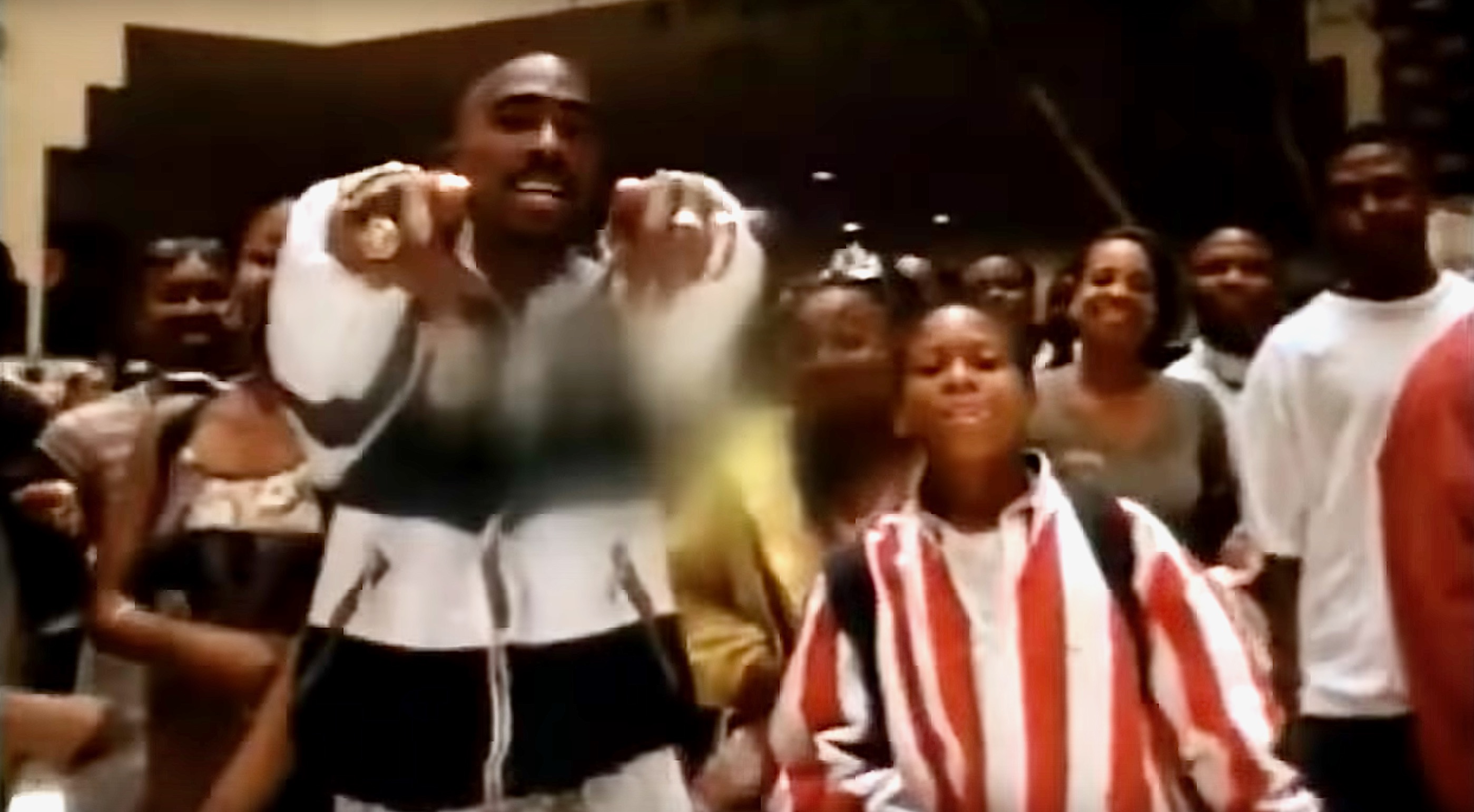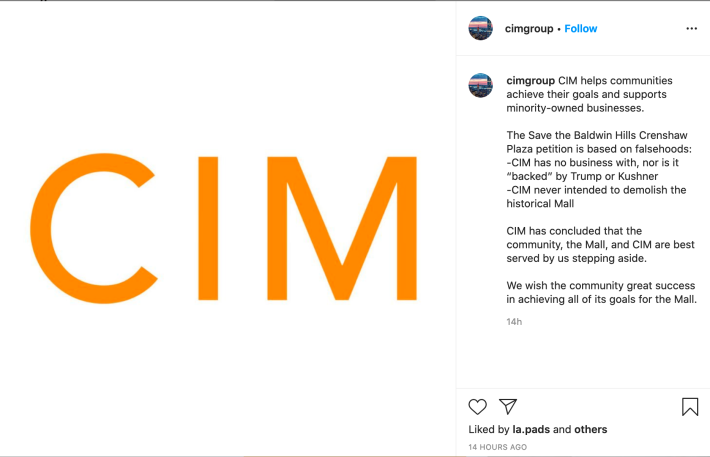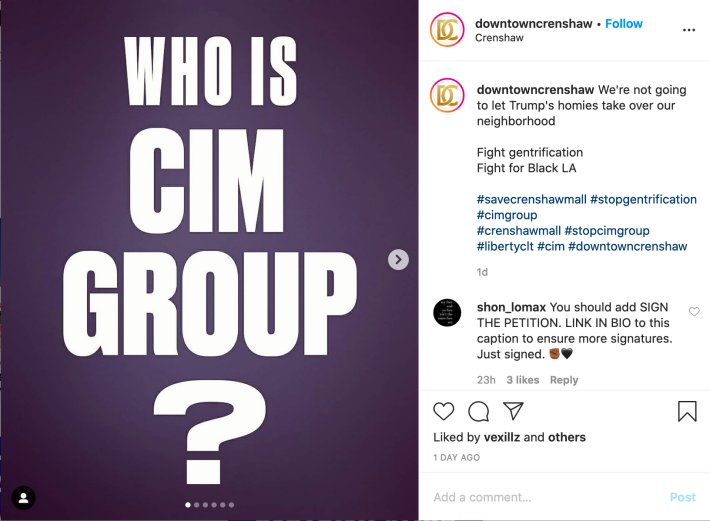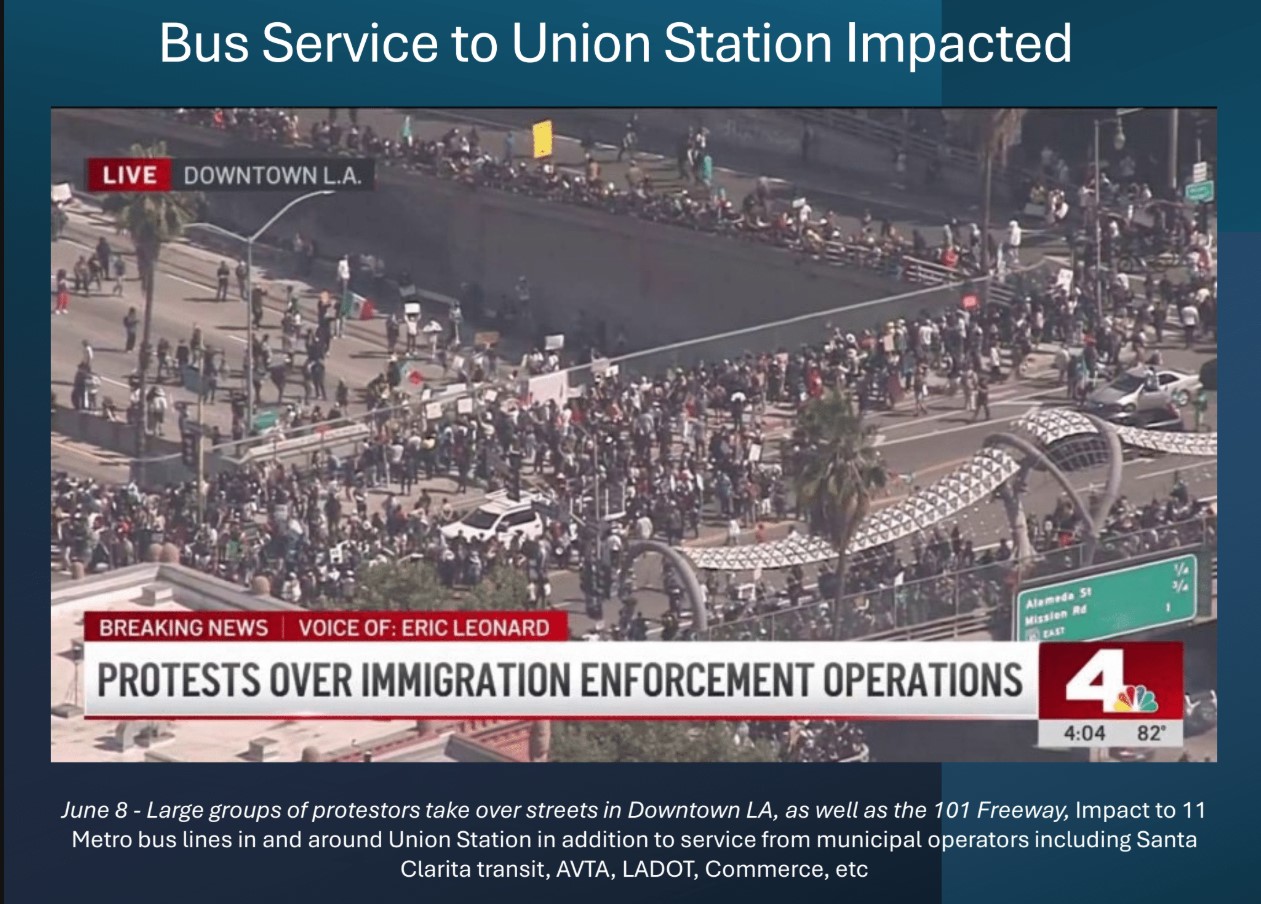This past Sunday, CIM Group announced on Instagram that it would be abandoning its effort to purchase the Baldwin Hills Crenshaw Plaza from the Capri Investment Group.
There was little information offered as to why. The post said only that CIM had "concluded that the community, the Mall, and CIM are best served by us stepping aside" and that they wished the community "great success in achieving all of its goals for the mall."
Press statements released Monday were equally opaque, focusing on rebutting what CIM deemed to be false statements from opponents to the sale regarding its ties to Donald Trump and Jared Kushner. Claims that CIM was "backed" by Trump or Kushner, CIM told the L.A. Times, had “caused the company to reflect on whether correcting the narrative and moving forward with the purchase of the Mall would be best for South L.A. and CIM at this unique time and place.”
CIM had likely singled out the Coalition to Save the Baldwin Hills Crenshaw Plaza’s (SBHCP) petition in its Instagram post (above) because it had racked up nearly 10,000 signatures online. But there had also been a second petition, this one from Downtown Crenshaw, which listed around 80 additional cosigning individuals and community organizations.
The two coalitions were not working together, but both had looked into CIM's ties to Trump and Kushner and made those associations a core talking point in the cases each was building against the mall deal.
The SBHCP had even sent out mailers similar to the flier below (taken from their website).
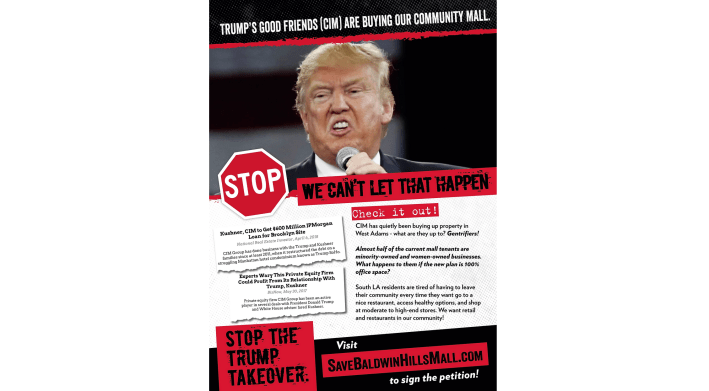
Given CIM's history, it's not clear that "correcting the narrative" would have helped improve their standing in anyone's eyes or made their project any more palatable.
Notably, CIM has usually been the one "backing" the deals of Trump and Kushner. The company's first deal with Trump was "stabilizing the scandal-plagued Trump SoHo hotel" in 2010, according to a WNYC report. And just prior to Trump taking office, the report continues, CIM helped Kushner purchase a $345 million parking lot in Brooklyn - one of seven deals CIM had done since 2010 that benefited one of the two men. CIM told WNYC in May of 2017 that it had only one remaining business relationship with a Trump-related company at that time (though Kushner Companies did not sell its stakes in two of CIM's Brooklyn projects until 2018). But the WNYC story also warned that the personal relationships CIM had built with both Kushner and Trump, as well as their reliance on public subsidies and government contracts, continued to raise a number of ethical questions about how they moved.
_______
CIM's announcement of its intent to purchase the mall from Capri at the end of April had rocked L.A.'s Black community, as well as the larger South Central community, breathing new urgency into discussions around community ownership. How could such a significant asset be sold out from underneath them without even the city councilmember first being advised?*
The move drew national attention, too, sparking conversations about community erasure across multiple social media platforms and becoming a trending topic on twitter for a day. Between the site's importance as one of California's oldest malls and as one of the few major retail venues that held on as disinvestment and white flight gutted the community, its cultural resonance, the fact that its sale was one of very few major real estate deals happening in the midst of the pandemic, and the decision by an otherwise "secretive" company to actively promote a story about a high-profile purchase that hadn't been completed yet, a lot of people were left scratching their heads about what CIM's ultimate objective was.
It was also difficult to overstate how much CIM's approach to both the property and the community had differed from that of Capri.
While Capri's most recent revitalization plans had left a number of stakeholders concerned about the acceleration of displacement along the Crenshaw corridor, the developer had at least made an effort to balance community needs and build on what was already there over the years.

When Capri had first shelled out $136 million for the mall back in 2006, for example, they made better integration of the property into the life of the surrounding area one of their key goals. They brought on the Debbie Allen Dance Academy as a tenant and incorporated free performances into the mall's programming. The events calendar eventually grew to include free fitness classes, concerts, a weekly farmers’ market, the Pan African Film and Arts Festival, and myriad other celebrations. Then, in 2011, Capri sank another $35 million into the first phase of the modernization of the property, including an overhaul of the Magic Johnson Theater and the construction of a new promenade, and prioritized local hiring, both in construction and at the movie theater.
The latest iteration of Capri's plans, approved by the city in 2018, included transforming the site into something akin to the Americana at Glendale, with nearly 1,000 residential units, a hotel, and additional retail and office space. Although the community process around the housing plans had often been contentious, Capri had continued to engage stakeholders about their vision for the site.

CIM's proposal, in contrast, didn't even offer the pretense of being community-serving.
In April, CIM co-founder Shaul Kuba told the L.A. Times that, “The success of Culver City and migration of [office] tenants going east to find better rent structure is opening the door" to a project like the one he envisioned for the site.
Kuba then went on to handily dismiss the mall's lengthy community process and the years' worth of debates regarding the corridor's future by saying, “You really want to make sure you are going through the right planning steps before you give up commercially zoned land for residential.”
In May, Kuba made it even clearer that he wasn't particularly concerned about preserving space for retail at the mall, telling Bloomberg that he would welcome those that had the capacity to reopen their doors (after being shut during the pandemic emergency), but that he didn't know how many would be able to do so. He appeared to be more interested in considering the possibility of building "creative" office spaces that would not only attract high-end tenants but also offer the potential to cash in on Opportunity Zone tax breaks.
_______
That the public announcement of CIM’s abandonment of the deal would come within six weeks of the announcement of the purchase took everyone by surprise.
Downtown Crenshaw had only begun to ramp up its social media campaign just two days earlier, said Damien Goodmon, the nascent collective’s co-founder.
It hadn’t been the only action Downtown Crenshaw had taken, of course.
Even though the group was formally barely a month old, its members had quickly organized to block the sale. Goodmon, former L.A. City Councilmember Robert Farrell, and long-time civil rights activist and founding board chair of Liberty Community Land Trust (LCLT) Baba Akili were among those who went before pension fund boards to encourage divestment from CIM and Capri. They had wanted those boardmembers to understand that financing these developers’ ventures could potentially contribute to the displacement of some of the very pension holders those boards served, said Goodmon. And they had wanted boardmembers to contemplate an alternative possibility: supporting a community-based land trust in Crenshaw that would work to keep the area affordable for and accessible to its long-time Black residents.
Both Downtown Crenshaw and LCLT had also begun a series of zoom/facebook live conversations intended to inform the community about the deal, build support for the effort to buy the mall and other properties in the area, and open a conversation around how to make the mall property truly community-serving once those 40 acres were finally in stakeholders’ hands.
They were not the only ones exerting pressure.
On May 7, President of the Baptist Ministers Conference Rev. K.W. Tulloss, President and CEO of the Southern Christian Leadership Conference of Southern California Pastor William D. Smart, and Pastor Jonathan Moseley Sr. of the National Action Network - all leaders of the SBHCP coalition - had gathered in front of the mall to speak on the lasting damage investors who did not care about the community could do.
They were concerned about the fact that CIM had already acquired several properties in West Adams and was actively seeking to move a younger, wealthier population into the historic Black community just northwest of the mall. “It’s time for the people to fight back and reject the organizations that have caused Black community pain for years,” Pastor Mosley had said in a statement at the time. “This is our area. And all of the gentrification that’s coming in and pushing us out - we will not stand for it.”
The fact that the SBHCP coalition was able to collect nearly 10,000 signatures on their petition within just a few weeks’ time spoke to just how deeply those concerns resonated far beyond the local faith community its leaders served.
_______
News of CIM's abandonment of the purchase traveled just as quickly through those same networks. Within twelve hours of CIM’s Sunday instagram announcement, news of what was being hailed as a community victory was already crackling through the cyberwires.
Speaking to L.A. Focus and in a facebook live post with Project Islamic Hope's Najee Ali on Tuesday, members of the SBHCP hailed the win at a "sacred space" - the intersection of Crenshaw and King - but acknowledged a long road lay ahead. The work of finding a developer that would provide the community with the project it desired, including affordable housing, quality jobs, and retail, they said, was just beginning.
Downtown Crenshaw was more upbeat, with Akili and others both lifting up the strategic wielding of community power as an example of what was possible and positioning themselves as the folks who should and could reclaim the mall.
"When our community comes together we can achieve anything," Akili said in the statement posted to the group’s website. “The breadth of community support and this incredible community victory is a testament to the power of the vision behind Downtown Crenshaw and our ability to organize both in the streets and in the halls of power.”
And while Downtown Crenshaw does indeed count this first step as a victory, Goodmon said, he can’t escape the fact that it has come at a steep price.
The reason cities, corporations, developers, and just about every other possible entity are willing to revisit their relationships with Black communities right now is because of the national reckoning sparked by the May 25 murder of George Floyd by Minneapolis police officers.
Few things had made that clearer than Akili and other representatives of Black Lives Matter Los Angeles (BLMLA) being invited to testify before the city council budget committee this past Monday regarding BLMLA's demands that the city defund the police and re-imagine public safety.
Akili had made the most of his time during the historic session, telling councilmembers he'd heard enough said about the importance of doing the right thing over his seventy-two years and that what he wanted to see instead was a commitment to real action. The Black community had been denied too much for too long in the name of safety and well-being for others, he had declared. So what were the councilmembers’ first steps going to be? What were they willing to put on the table?
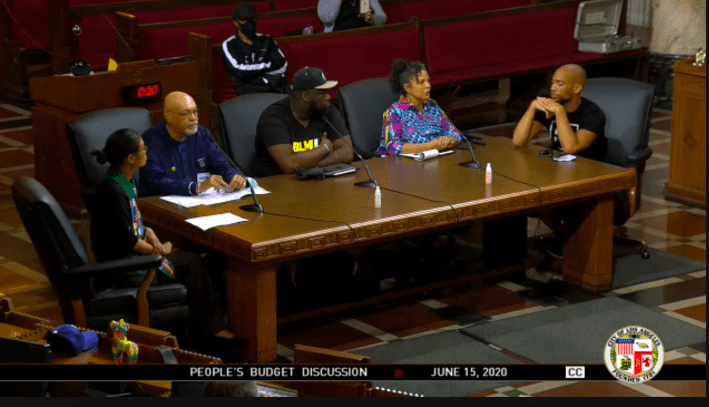
Genuine as Akili's question was, Downtown Crenshaw and the Liberty Community Land Trust were both born out of the idea that the Black community cannot wait for elected officials to do the right thing.
Downtown Crenshaw - conceived as an “impact fund” to support the LCLT’s efforts to take housing off the speculative market and “make our community permanently affordable to us" - had been in the works for going on two years, Goodmon said. The COVID-19 emergency coupled with news of the mall purchase had accelerated the timeline for pulling it together.
Goodmon also made clear that these ideas were not new - conversations around land trusts had dated back at least to the last uprising. But the rate that the Black community was being squeezed out of L.A. meant that they could no longer afford to keep playing catch-up. Ensuring “a future for Black Los Angeles," he said, required land ownership and community control.
"It’s the only way we save Black L.A.”
_______
Join members of the Crenshaw Subway Coalition, Downtown Crenshaw, and Black Lives Matter-L.A. as they lead a Juneteenth caravan/march on the mall and uplift the spirit of Grechario Mack - the 30-year-old man who was killed by LAPD in the mall in 2018 while suffering a mental health episode. The march will begin at 2 p.m. at the intersection of Obama and King Blvds. Listen in to a TEC Leimert instagram live conversation with Downtown Crenshaw tonight at 6 p.m. to learn more about the victory, the group, and their process.
*When the sale of the mall was first announced, many asked how it was that city officials, including Eighth District Councilmember Marqueece Harris-Dawson, didn't know this was happening or didn't do more to stop it. The seller had no obligation to let the city know of the sale, and because CIM was not looking to make any changes to the mall (other than abandoning Capri's plans), they did not have to let the city know, either. The city comes into play when the developer wants to make changes to a property that go beyond what existing zoning allows. CIM clearly did not even bother to consider the significance of the mall to the community - their first calls regarding the potential sale were to press outlets, not the councilmember or community leadership.
For more on the history of the mall project, see:
